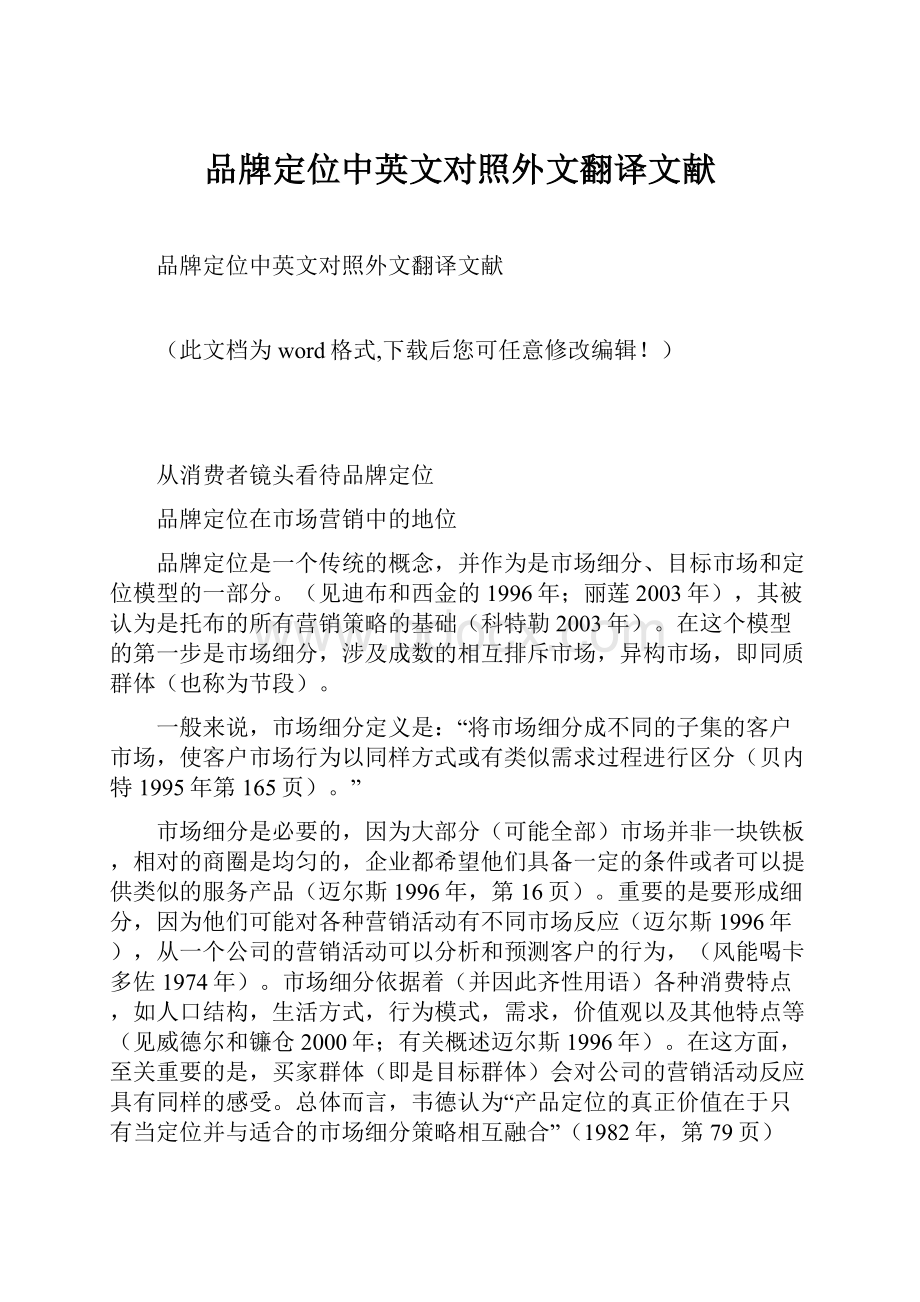品牌定位中英文对照外文翻译文献.docx
《品牌定位中英文对照外文翻译文献.docx》由会员分享,可在线阅读,更多相关《品牌定位中英文对照外文翻译文献.docx(4页珍藏版)》请在冰豆网上搜索。

品牌定位中英文对照外文翻译文献
品牌定位中英文对照外文翻译文献
(此文档为word格式,下载后您可任意修改编辑!
)
从消费者镜头看待品牌定位
品牌定位在市场营销中的地位
品牌定位是一个传统的概念,并作为是市场细分、目标市场和定位模型的一部分。
(见迪布和西金的1996年;丽莲2003年),其被认为是托布的所有营销策略的基础(科特勒2003年)。
在这个模型的第一步是市场细分,涉及成数的相互排斥市场,异构市场,即同质群体(也称为节段)。
一般来说,市场细分定义是:
“将市场细分成不同的子集的客户市场,使客户市场行为以同样方式或有类似需求过程进行区分(贝内特1995年第165页)。
”
市场细分是必要的,因为大部分(可能全部)市场并非一块铁板,相对的商圈是均匀的,企业都希望他们具备一定的条件或者可以提供类似的服务产品(迈尔斯1996年,第16页)。
重要的是要形成细分,因为他们可能对各种营销活动有不同市场反应(迈尔斯1996年),从一个公司的营销活动可以分析和预测客户的行为,(风能喝卡多佐1974年)。
市场细分依据着(并因此齐性用语)各种消费特点,如人口结构,生活方式,行为模式,需求,价值观以及其他特点等(见威德尔和镰仓2000年;有关概述迈尔斯1996年)。
在这方面,至关重要的是,买家群体(即是目标群体)会对公司的营销活动反应具有同样的感受。
总体而言,韦德认为“产品定位的真正价值在于只有当定位并与适合的市场细分策略相互融合”(1982年,第79页)
STP模型的第二个步骤是目标市场的选择,定位评估在细分过程中起决定性作用,其中商圈的目标是公司应该竞争的各个环节。
(弗里德曼和莱辛1987年)。
这项评估主要是基于本部门的整体经济吸引力以及公司的目标和公司资源状况(科特勒2003)。
更具体的说,在评估环节中,重点是细分的大小,所需资源渗透到公司的长处和短处,替代品纯在和内部和外部的产品类别(波特1980)。
在一般情况下,一个品牌能以最好的方式得到满足,营销人员是细分的重要关注环节(科特勒2003)。
在这种情况下,品牌在市场细分中所得到的消费者价值,超过其他部门所作出的,因此,目标市场的决定受定位选择的影响。
STP模型的最后一步是定位,在逻辑上被定义于遵循适当的目标细分市场。
(克劳福德1983)。
定位决定目标的品牌涉及配售的方式,使得目标市场认为它不同于并优于竞争对手(克劳福德1985;科特勒2003;迈尔斯1996年)。
定位很重要,因为它“确定营销活动和方案的方向——酸奶品牌应该或不应该做他的营销”。
(科乐和莱曼2006年第740)因此,制定营销方案,确保市场营销组织的决策和支持是一致,都是依靠定位(阿克尔1982年)。
例如,当一个公司要拥有很高的威望,它可以通过限制发行网点,或降低要求生产,支持更高的价格印证(例如,铢和瑞莉1998年)。
因此,营销组合的直接和即时的影响“品牌的定位策略的战术细节,任何的定位决定了整个营销组合的直接和即时的影响”(埃文斯第168页)。
相反,营销组合的所有元素——促销,定价,分销,当然,还有产品——是定位的关键因素(斯和达克1987)。
因此它们对消费者的感性空间是具有影响的。
(和马哈詹1989;艾尔逊2004;里斯和特劳特1986年)。
此外,在营销团体的所有成员必须相互协调,以至于将公司定位于最接近消费心智中的地位(克劳福德1985年)。
BrandPositioningThroughtheConsumers’Lens
ChristophFuchs.(2008)
OriginallyPublishedinWien,1-8
THEROLEOFBRANDPOSITIONINGINMARKETING
Brandpositioningistraditionallydiscussedaspartofthesegmentation,targetingandpositioning(STP)model(seeDibbandSimkin1996;LilienandRangaswamy2003),whichisconsideredtobethebasisforallmarketingstrategy(Kotler2003).Thefirststepinthismodelissegmentation,whichinvolvesdividingaheterogeneousmarketintoanumberofmutuallyexclusivesubmarkets,i.e.homogeneousgroups(alsoreferredtoassegments).
Formally,segmentationisdefinedasthe“processofsubdividingamarketintodistinctsubsetsofcustomersthatbehaveinthesamewayorhavesimilarneeds”(Bennett1995;p.165).Segmentationisessentialsince“most(probablyall)marketsarenotmonolithicbutinsteadconsistofsubmarketsthatarerelativelyhomogeneousintermsofwhattheyneedorwantfromfirmsofferingsimilartypesofproductsofservices(Myers1996,p.16).Itisimportanttoformsegmentsbecausetheyarelikelytoresponddifferentlytovariousmarketingactivities(Myers1996)andarerelevantforexplainingandpredictingcustomerbehaviortoacompany’smarketingactions(WindandCardozo1974).Segmentscanbebasedupon(andarethushomogeneousintermsof)variousconsumercharacteristicssuchasdemographics,lifestyles,behavioralpatterns,needs,values,andothercharacteristics(seeWedelandKamakura2000;Myers1996foranoverview).Inthisregard,itisessentialthatbuyergroups(thataretargeted)respondsimilarlytocompany’smarketingactivities.Overall,Wind(1982,p.79)contendsthatthe“realvaluesofproductpositioningisrevealedonlywhenthepositioningiscoupledwithanappropriatemarketsegmentationstrategy.”
ThesecondstepintheSTPmodelisthetargetmarketselection.Targetinginvolvesassessingthevarioussegmentsidentifiedinthesegmentationprocesswiththeaimofdetermininginwhichsubmarketsthecompanyshouldcompete(FriedmanandLessing1987).Thisassessmentisprimarilybaseduponthesegment’soveralleconomicattractivenessaswellthecompany’sresourcesandobjectives(Kotler2003).Morespecifically,inevaluatingthesegments,particularfocusisputonfactorslikesegmentsize,resourcesrequiredtopenetratethesegment,firmstrengthsandweaknesses,presenceofsubstituteswithinandoutsidetheproductcategory(Porter1980).Ingeneral,marketersarerecommendedtofocusonsegmentswhichabrandcansatisfyinasuperiorway(Kotler2003).Inthiscontext,itisimportanttorecallthatsomeconsumersegmentsvaluecertaindifferentialclaimsmadebybrandsmorethanothersegments,thus,thetargetsegmentdecisioninfluencesthechoiceofthepositioning.
ThelaststepintheSTPmodelispositioning,whichlogicallyfollowsaftertheappropriatetargetsegmenthasbeendetermined(Crawford,Urban,andBuzas1983).Positioninginvolvesplacingabrandinawaythatthetargetmarketperceivesitasdifferentandsuperiorinrelationtocompetitions(Crawford1985;Kotler2003;Myers1996)1.Positioningisimportantasit“setsthedirectionofmarketingactivitiesandprograms-whatthebrandshouldandshouldnotdowithitsmarketing”(KekkerandLehmann2006;p.740).Thus,thedevelopmentofthemarketingprogramshouldbelinkedtothepositioningtoensurethatmarketingmixdecisionsareconsistentandsupportive(AakerandShansby1982).Forexample,whenacompanyclaimshighprestige,itcansupportthisclaimbychargingapremiumprice,bylimitingthenumberofdistributionoutlets,andbyproducinglessthandemanded(e.g.BhatandReddy1998).Themarketingmixcanhencebeviewedas“thetacticaldetailsofthebrand’spositioningstrategy,anydecisiononpositioninghasdirectandimmediateimplicationsforwholemarketingmix”(Evans,Moutinho,andvanRaaij1996,p.168).Conversely,allelementsofthemarketingmix-promotion,pricing,distributionand,ofconsumers(EasingwoodandMahajan1989;Ellson2004;RiesandTrout1986;).Moreover,allmembersofthemarketingteamneedtobecoordinatedinordertobecomethepositioningascloseinconsumers’mindsasintendedbythecompany(Crawford1985).
原文题目:
《从消费者镜头看待品牌定位》
作者:
ChristophFuchs
原文出处:
2008,Wien,1-8